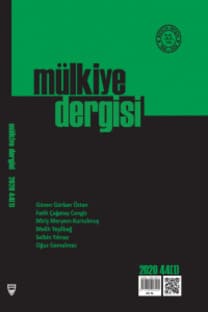III. Cumhuriyetin Kuruluşunda Yargı Tasfiyeleri
Modern Fransız Cumhuriyet Rejiminin kuruluş yıllarında, III. Cumhuriyet’in ilan edildiği 1870 yılındanitibaren, köklü bir idareci ve yargıç temizliği gerçekleştirilmiştir. İdarenin üst kadrolarının ve yargı mensuplarının tasfiyesi yeni siyasal rejimin kurulmasında temel araçlardan olmuştur. Tasfiye, idarenin ve yargının (Danıştay ve Yargıtay) üst kademelerinin cumhuriyet karşıtı niteliğini değiştirmeyi amaçlamıştır. Laik eğitimi kuran reformlara ve izinsiz tarikatların dağıtılmasına karşı tarikatların ve Kilise’nin verdiği tepkinin yargıdan ve Danıştay’dan destek bulmasını da engellemek gerekmiştir. Danıştay temizliği sayı artırma, görevden alma, emekliye sevk etme, istifa zorunda bırakma, görevde yükseltme ve yeni atama yöntemleriyle gerçekleştirilmiştir. 13 Temmuz 1879 tarihli Yasanın uygulanması ile Fransız idari yargı tarihinin en büyük tasfiyesinin gerçekleştirildiği kabul edilmektedir. Cumhuriyetçiler, devleti burjuva cumhuriyetinin ilkeleriyle düzenleyebilmek için bürokraside ve yargıda büyük tasfiyeler gerçekleştirmiştir. Bu basit bir “adamını yerleştirme” değil, bir “temizlik” olmuştur.
Anahtar Kelimeler:
İdari yargı, yargı tasfiyesi, Danıştay, tarikat, Üçüncü Cumhuriyet
-
Establishment years of modern French Republican Regime, began by the proclamation of III. Republic in 1870, witnessed the great political purge of the bureaucracy and of the judiciary. Purging the higher class of administrative body, the judiciary among them the Court of Cassation and the Council of State was the one of the most effective instrument in establishment of new political regime. Main purpose of this purge was to break up the anti-republican tendencies in bureaucracy and in judiciary. Reforms for secular education and the administrative dissolution of sects gave way to a hard political reaction of the Church and of sects. By the purges Republicans tried to impede these reactions to get support from judiciary. In purging Council of State they used different methods, namely, creating new posts, forcing to retirement and to resignation, promotions and new designations. Application of the Law of 13 July 1879 is considered as the greatest purge in the history of the French administrative justice system. This was not a simple favoritism but genuine political purge
Keywords:
Administrative justice, Purge of judiciary, Council of State, Sects, Third Republic,
___
- Basdevant-Gaudemet B (1999). Le Conseil d’État et les question religieuses au XIXe siècle. La revue administrative, 26.
- Baubérot J (2007). Histoire de la Laïcité en France. 4. Baskı, Paris: PUF.
- Bernaudeau V (2003). Justice, Politique et Franc-Maçonnerie sous la Troisième République: un conseiller à la Cour d’appel d’Angers, Victor Jeanvrot. Revue d’histoire
- du XIXe siècle, 26/27
- Bernaudeau V (2011). L’anjou, la République et ses juges, Epuration du corps judiciaire, entre réaction de légitime défense et instrument de consolidation du régime (1883). Criminocorpus: Revue d’Histoire de la justice, des crimes et des peines, 2011
- Bouchery R ve Machelon J-P (1993). L’épuration Républicaine 1870-1871 (Siège et parquet) / 1872-1882 (Parquet). Revue Histoire de la Justice, sayı 6.
- Catta T (1930). le Cinquantenaire d’un coup de force, décrets du 29 mars 1880 et l’épuration de la magistrature. Revue catholique des institutions et du droit, 1930, s.385-414
- Dansette A (1948). Histoire Religieuse de la France Contemporaine, De la Révolution à la Troisième République. Paris: Flammarion.
- Dansette A (1951). Histoire Religieuse de la France Contemporaine, Sous la Troisième République. Paris: Flammarion.
- Hanotaux G (1903). Histoire de la France Contemporaine (1871-1900). cilt IV, Paris: Ancienne Librairie Furne, Paris.
- Lavisse E (1921). Histoire de France Contemporaine, Depuis la Révolution jusqu’a la paix de 1919. cilt 8, Paris: Librairie Hachette.
- Lhomme J (1960) La Grande Bourgeoisie au Pouvoir (1830 – 1880). Paris: PUF.
- Machelon J-P (1993). L’épuration Républicaine. La loi du 30 août 1883. Revue Histoire de la justice, sayı 6.
- Weidenfeld K (2010). Histoire du droit Administratif. Paris: Economica.
- Wright V (1972). L’épuration du Conseil d’État en Juillet 1879. Revue d’Histoire Moderne et Contemporaine, s. 621-656.
- ISSN: 1305-9971
- Yayın Aralığı: Yılda 4 Sayı
- Başlangıç: 1965
- Yayıncı: Mülkiyeliler Birliği Genel Merkezi
Sayıdaki Diğer Makaleler
“Benim Milletim…”: AK Parti İktidarı, Din ve Ulusal Kimlik
Yeni Bir Demografik Hareketlilik Dönemi Olarak Birinci Dünya Savaşı'nın Sonu: Kayseri 1918-1920
Yeni Türkiye’nin “Dava” Seferberliği ve “Muarızları”
İnkâr Siyasetinde Kırılma: Hrant Dink’in Kendisi ve Öldürülmesi
Diran Kelekyan, ÇEV. FARUK ALPKAYA
İnsanlar Asıl Unutulunca Ölür: Diran Kelekyan
Etnik Gruplar Arası Sorunların Yeniden İfadesine Yönelik Bir Girişim
Broghos Levon Zekiyan, ÇEV. TUNCEL ÖNCEL
Görsel Gerçekçilik Rejiminin Sonu mu? “Yeni” Medya Döneminde Sinema
Yerel ve Ulusal Ölçekte Lazlığın Etnik Sınırlarının Yeniden İnşası: Dil, Hafıza, Kültür
